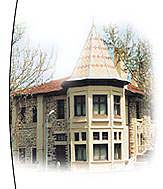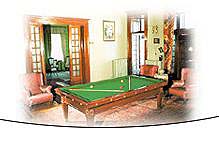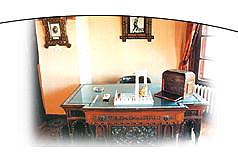Ankara - Atatürk's Residence Museum Pavilion
 Who would have thought that this vineyard house, built at the end of 1800’s in the village of Cankaya in Ankara, would be the witness of the history by being the residence of a worldwide known leader who would change the faith of his nation?
Who would have thought that this vineyard house, built at the end of 1800’s in the village of Cankaya in Ankara, would be the witness of the history by being the residence of a worldwide known leader who would change the faith of his nation?
From the day he arrived in Ankara on 27 December 1919, until 1921 Atatürk first resided in the School of Agriculture and than after being elected as the President of the Turkish Grand National Assembly, resided in the stone building near the Central Station. In June 1921 he moved to this vineyard pavilion. Today you can see the inscription at the entrance of this house where Atatürk lived most of his 56 years of life-span:
“This is an old vineyard house. It was bought by Bulgurluzade Mehmet and Rifat Beys of Ankara and, in 1921, presented to Atatürk under the leadership of Ankara Müfti Hodja Rifat Börekci in the name of Ankara people. Atatürk accepted this present in the condition that it was to be transferred to the Army and named “Army Pavilion”. Originally two-storey building has a marble pool in the ground floor ante hall. After a minor refurbishment Atatürk moved to this house in June 1921 from the Ankara Station building where he was residing.
In 1924 additions and restorations made by architect Mehmet Vedat Bey brings the building to its present state.
These additions are the glazed entrance in the front, a longitudinal office and a new kitchen at the back, and the tower at the side. This building, used as the first Presidential Palace of the Turkish Republic until the new Presidential Palace built in June 1932. This building, which has an important place in the history of the Republic, is preserved in its original state with all its furnishings.
 When you put your feet onto the entrance courtyard of this modest house, which later on restored to a pavilion and furnished with a good taste and comfort but still away from the splendour of grand palaces, you will find yourself in the 1920’s.
When you put your feet onto the entrance courtyard of this modest house, which later on restored to a pavilion and furnished with a good taste and comfort but still away from the splendour of grand palaces, you will find yourself in the 1920’s.
While your mind and feelings try to adjust themselves to this sudden trip in history, your body will reach to the hall. And, from than on, you will start to live in the past. You will see the traces of Atatürk on the furniture, in every corner, and will be seized with a feeling expecting that he will suddenly come out from one of the doors. With an excitement of feeling like living in those days, the whole building will settle in your brain. It is important to mention that the pool table at the entrance hall, which Atatürk played during his residence in this villa, used to be in the hall at the top floor. But it was moved to the ground floor with a worry that, being a very heavy table, it might collapse the floor of this old building.
Right across the hall the Dining Room door, at the right side of the hall the door of the Green Room and on the left side the door of the Envoys Reception Room and the stairs going to the top floor will invite you to know this Museum Pavilion. In the hall you will see the piano and the seating group. On the walls two paintings and the photographs of Atatürk, taken in various dates, are hanged. The middle door of the hall, which has three entrances, is closed and the pool closet is placed in front of it. The beauty of the kilim drapery covering that door will draw attention. All these years have never changed the elegance of the drapery.
In the Envoy Reception Room at the left side of the hall, a lounge room suite, presented to Atatürk by the Khedive of Egypt, Abbas Hilmi Pasha, and very much loved by him, consist of three armchairs, a settee, a study desk and a closet, all with nacre work, can be seen.
When you enter to this room, you will have a feeling covering your consciousness that you are in the presence of Atatürk. Some photographs on the walls with nacre-work frames and the photograph on the study desk virtually will draw the person towards them. On the photograph you will read this handwritten note: “21 September 1935 - From Istanbul to Ankara, in the railway car”.The Green Room that is across the Envoy Reception Room, with its lounge room suits, glass cabinet and photographs, is the reception and lounge room. It also has an opening to the dining room.
The dinners given by Atatürk in Cankaya are very well known. When you enter to the dining room you may feel yourself like an early arrived guest. The first thing that will catch the eye in that room with the furniture unique of its time is the fireplace right across the door opening to the hall with engraved woodwork covering both sides and the chimney and the windows with stained glass at both sides of the fireplace. There is also a breakfast table for four, and a poker table near by the entrance of the Green Room.
Two glass cabinets, a sideboard, a console table, two phonographs and two large earthenware vases are placed harmoniously within the room and around the fireplace. The sets placed in the glass cabinets and in the sideboard are just like ready for use. In the middle of the room right in front of the settee a large silver brazier gives a different image to the room.
In the hall, above the Dining Room door, a painting of Hüseyin Avni Lifis dated 1922 and above the Green Room door, the “Crying Woman” painting of the same painter signed with arabic letters, will suddenly catch your eyes.
The dirge sang to martyr, whose belongings are the only things returned from the front, will reverberate in your ears. When you exit from the dining room, the stairs just at the right side of the door will take you to the private moments of Atatürk’s life.
On the top floor there are six doors opening to the hall. One is the door that enters to the hall from the stairs. The one at the left, the bedroom door; the one at the right is the rest room door; the door looking towards the front is the balcony door and the one right across is the library door. An oval table (where the pool table was before), a couch, two armchairs and two glass cabinets are placed in the middle of the hall. There is a big brazier placed in front of the balcony door. In one of the cabinets the medals of Atatürk and the National Assembly membership certificate; in the other the first sets of Atatürk postage stamps are displayed.
The rest room, which also has a door opening to the stair hall, is a small modest bedroom for a single person. A divan, an armchair, a small desk, a wardrobe and two hassocks are in the room. A wall clock, a painting and photographs of Atatürk and Fethi Okyar, decorates this room. It is rumoured that Atatürk loved this room very much.
 Both doors across the rest room open to the library. When you enter to the library from the right, you can almost feel that Atatürk is sitting on the study desk. Perhaps, Atatürk has formed most of his ideas while sitting on this desk. He started to write the “The Great Speech” in this library.
Both doors across the rest room open to the library. When you enter to the library from the right, you can almost feel that Atatürk is sitting on the study desk. Perhaps, Atatürk has formed most of his ideas while sitting on this desk. He started to write the “The Great Speech” in this library.
The books in the library are the important evidences of how Atatürk has broadened his horizon and formed his cultural structure. It is possible to see how he had taken notes in the pages, and underlined some sentences.
You can pass to the tower room from the rear end of the library, where a section furnished like part of the library with some more bookshelves, a round table with four chairs and an armchair in the corner with a floor lamp and this section also has a door opening to the bedroom. In the tower room, which the dark colours dominate, again a study desk, armchairs and a bear hide, a present of Muhtar Bey, the Ambassador for Moscow, can be seen.
Now your steps convoy you to the last section, the most private space of a man; the bedroom. The bedroom also, as any other sections of the pavilion, is decorated simply and with a good taste. The bed of Atatürk is kept with his pillow, quilt and bedspread as it was on those days. His slippers at the side of the bed give a feeling that the owner will just come in to the room and wear them. One of the two dressing tables is placed next to the bathroom. The toilet articles on the dressing table are known that they belong to his wife Latife Hanim. The only evidences of Latife Hanim in the pavilion, during Atatürk's marriage to her between the dates 9 January 1923 and 5 August 1925, are these toilet articles.
In the bedroom besides a wardrobe, an armchair and a small round table with chairs, the youth photograph of Zübeyde Hanim hanged on the fireplace attract attention. The bathroom was made of the best material available in those days. Besides the inlaid bathtub a door opens to a stair hall. Your tour within the residence of Atatürk ends with the bathroom. When you go down from the stairs and go out of the pavilion, your eyes will meet what Atatürk calls “my greatest work” with the modern Capital of the Republic, Ankara.
Address: Presidential Palace Garden, Cankaya, Ankara
Telephone: +90 (312) 427 43 30 ext. 317